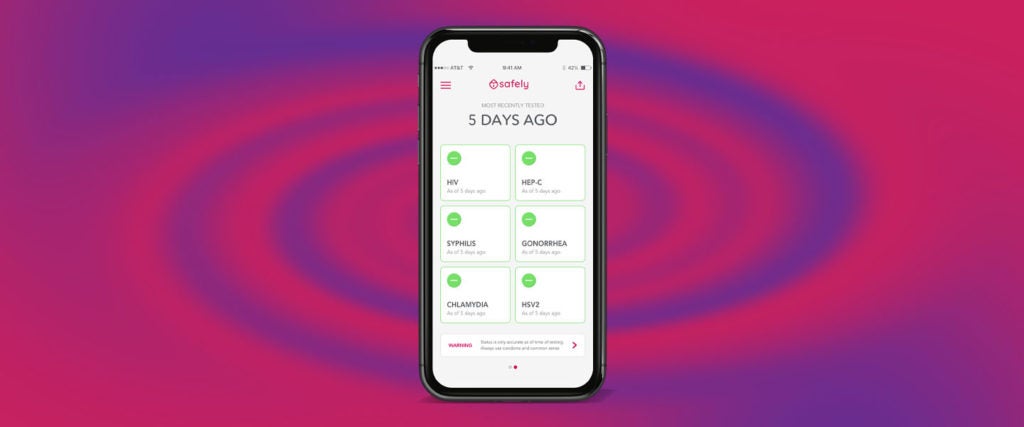In the arid dust bowl of the Nevada desert, Lauren Weiniger had a big idea.
It was 2015, and the Atlanta-born entrepreneur was at Burning Man enjoying her recent freedom from a long-term relationship. Joined by another newly-single friend, Weiniger was celebrating: She was back on the dating scene, and ready to venture into the world of casual sex.
Only, there was a problem. “So many people were asking if we’d been tested, as STI rates were reaching an all-time high,” Weiniger remembers. Many Burning Man revelers were also refusing to use condoms, opting instead to only have sex with people “who had already been tested and could prove it.”
But getting this kind of information wasn’t — and still isn’t — particularly easy. As well as being expensive, STI testing styles vary: Results can be sent via app, call, text or just through an in-person physical test, which means that portable proof isn’t always guaranteed. With all this floating in her head, Weiniger, suddenly, was struck with a thought: “Why has there never been an easy way to verify somebody’s sexual health status?”
Safely, an app dedicated to doing exactly that, was born five years later. Co-founded and run by Weiniger, it aims to be the first “private and practical solution” to sharing your sexual health status. Users can import their STI test results — including HIV, gonorrhea, chlamydia, HEP-C, genital herpes and syphilis — from wherever they were last tested, and show them to any selected potential partners. They can also use the app to speak to sexual health experts and book future checkups (for a flat rate of $99, or a co-pay if they have insurance).
On the surface at least, Safely — which launched officially in July this year — has had a promising start. Against the odds, it’s managed to partner up with “around 92 percent” of U.S. insurers, which is an impressive feat given the fragmented state of the country’s health-care system. There are also plans to team up with dating apps (giving swipers the option of an STI safe “badge”), and to introduce an additional sharing option for COVID test results.
“Safely is for anyone having sex outside of a completely monogamous relationship,” Weiniger explains, adding that the app’s current audience is made up of all genders and sexualities. However, the goal is to speak “more to the heterosexual population, and particularly to women. We want this mainly to be a message of empowerment for them, to help them feel comfortable demanding transparency from their partner.”
The reviews seem to be enthusiastic, too. Despite the odd bug report, users are generally happy with the Safely experience, hailing it as “freakin amazing,” easy to use and a great addition to “a world of uncertainty.” A 41-year-old woman from San Francisco tells me that the app is — as Weiniger hoped — an “empowering” addition to her sex life, and credits it for wiping away some of the “stigma” that still lingers around STIs. “Safely is a great way to open the discussion of testing,” she writes over email.
Ina Park, author of Strange Bedfellows: Adventures in the Science, History and Surprising Secrets of STDs, is equally enthusiastic. “Sharing STI test results with partners is important,” she explains, “because when someone says, ‘I’m negative,’ you don’t really know what that means.”
And judging by the urgency of the national sexual health stats, we definitely needed something. In the U.S., STIs are on the rise, with combined cases of gonorrhea, chlamydia and syphilis now at an all-time high (something that hasn’t been helped by consistent cuts to the public health budget). Condom use is also at an all-time low — go figure! — with up to 50 percent of 18- to 34-year-olds admitting to never using one.
COVID has only made this mess worse. The demands of the recent pandemic have stretched services, putting 83 percent of HIV and STI disease tracers on the coronavirus trail, and limiting the services of many sexual health clinics. As a result, STI rates are continuing to rise, while both testing and treatment dwindle.
Safely, then, may have arrived at the perfect time. By simplifying the sexual health booking process and giving users a direct line of communication to doctors, it offers an easy and accessible solution to the growing STI crisis. “I thought our numbers would drop to zero during the pandemic,” says Weiniger, a speck of surprise in her voice. “But our organic reach actually doubled, which was really interesting. People were still hooking up! They were still going on dating apps! They [just weren’t] going into the doctor’s office.”
However, there are still plenty of problems Safely has to grapple with. After all, if 50 percent of people are refusing to wear a condom — which isn’t exactly a complex procedure — then why would they feel more inclined to use an app? Can it really break such a stubborn, widespread cultural habit?
For this reason, Ben (not his real name), a 28-year-old sexual health adviser in New York, believes that Safely is unlikely to solve the STI crisis, and says that the only real solution is major systemic change. “The problem is our education system,” he says. “I would use this app, but I don’t think younger generations would because they’re just not aware of how damaging STIs can be. They don’t take them as seriously, because they’re not being actively taught about their devastating long-term effects.”
Charlotte, a 35-year-old nurse from Toronto, agrees. “The app is a neat idea,” she adds, “but in my experience, I just don’t see this being something that would be utilized frequently.”
When I reach out to redditors about whether they’d use Safely, the responses are mixed. While many initially agree that the app sounds like a great idea, there are still reservations. Some cite privacy concerns, and are skeptical over involving a third party in their health-care routine (though Weiniger stresses that all information shared on the app remains secure). Others question whether the app is even necessary, as many health insurers already offer the option to digitally share STI results.
“I wouldn’t use Safely,” says Evan (again, not his real name), 25 from Texas. “I can already pull up my stats on my doctor office app, which doesn’t prove anything anyway — just that you were clean at that one moment.” Besides, he adds, unless someone is updating their test results every week, how do you truly know that they’re safe to sleep with? “If you sleep around, those results won’t always be up to date.”
There’s also the concern that the app might encourage more barebacking, with users potentially putting too much trust in results that might not be accurate at the time of checking. Weiniger, though, is quick to dismiss this theory, and says that Safely loudly encourages all users to use both “common sense” and “condoms.” “I believe Safely can, in some cases, remind people to use condoms,” she says. “Yes, the app is only as good as your last test date, and anything could have happened since then. But people know that, and sharing your results is a lot better than nothing.”
As well as encouraging a more open dialogue, she adds, the app can also offer a clearer portrait of how responsible a potential partner is: “Somebody who was tested two weeks ago has much lower risk potential than somebody who was never tested, or tested eight months ago.”
For now, the future of Safely is — like pretty much everything else in the world — uncertain. While it’s easy to be skeptical about its broader appeal, we have to take into account the seismic shifts currently taking place in our health-care systems. As well as making people generally more health-conscious, COVID is also normalizing the medical testing process, and helping to bring more medical services online.
As such, Weiniger is optimistic. “Keeping other people safe is something that’s really being drilled into us now, for the first time,” she explains. “When Safely started, we were solving the STI crisis, which is still very much raging in the U.S. and worldwide. COVID is now much more urgent, but also similar.”
And an app that makes it easier to get tested and to provide verification for both these issues, she argues, is exactly what’s needed.

